Who doesn’t like the fascinating Coos of Doves? I certainly do. Doves and pigeons are beautiful species of birds and are often used as a symbol of peace, freedom, and love. Florida is home to a variety of dove species, but the Mourning and Rock Doves are the most prevalent.
They both like warm temperatures, which is only one of the numerous factors behind their existence in Florida.
Doves were first tamed for their feathers and are native to Europe and Asia. They may converse with other birds or woo potential partners by cooing. In the United States, doves are now often kept as pets.
Although they are also native to Asia and Europe, doves have been present in North America for more than 500 years. They are regarded as one of the most intelligent bird species, and since they can navigate via landmark signals, they are especially well-suited to live in cities. They are renowned for their capacity for composure under pressure and propensity for creating complex nests.
Here is a list of doves in Florida, some of which are endangered and protected.
List of Doves in Florida
1. Common Ground-Dove

Image Source
- Scientific name: Columbina passerina
- Lifespan: 7 years
- Size: 15 to 18 cm
- Native to: Southern United States, parts of Central America, the Caribbean, and northern South America
The Common Ground-Dove is a migratory bird whose population has been falling recently. Given that these birds depend on open areas for breeding and living, it is thought that human activities like habitat destruction and hunting are to blame for this reduction.
You may assist in saving the Common Ground-Dove by notifying a conservation group like WildEarth Guardians about any sightings of these birds. Additionally, you may assist programs like Restore Florida, which aims to save crucial ecosystems in the state. To assist create additional green space around your house, you may also plant trees or flowers. This will benefit the local wildlife, including the dove.
2. Inca dove

Image Source
- Scientific name: Columbina inca
- Lifespan: 8 years
- Size: 6.5–9.1 in
- Native to: Southwestern United States and in northern Central America
The Andes Mountains in South America are home to the little Inca dove (Columbina Inca). It is regarded as a rare bird, and although though little research has been done on it, it is thought to be in danger of becoming extinct.
One of the rare wild dove species that builds its nests in high-altitude areas is the Inca dove. It typically lays two eggs and builds its nest by filling a protected hollow in a tree or rock with wood. The young birds hatch out and depart the nest after around 23 days of incubation by both parents.
3. Key West Quail-dove
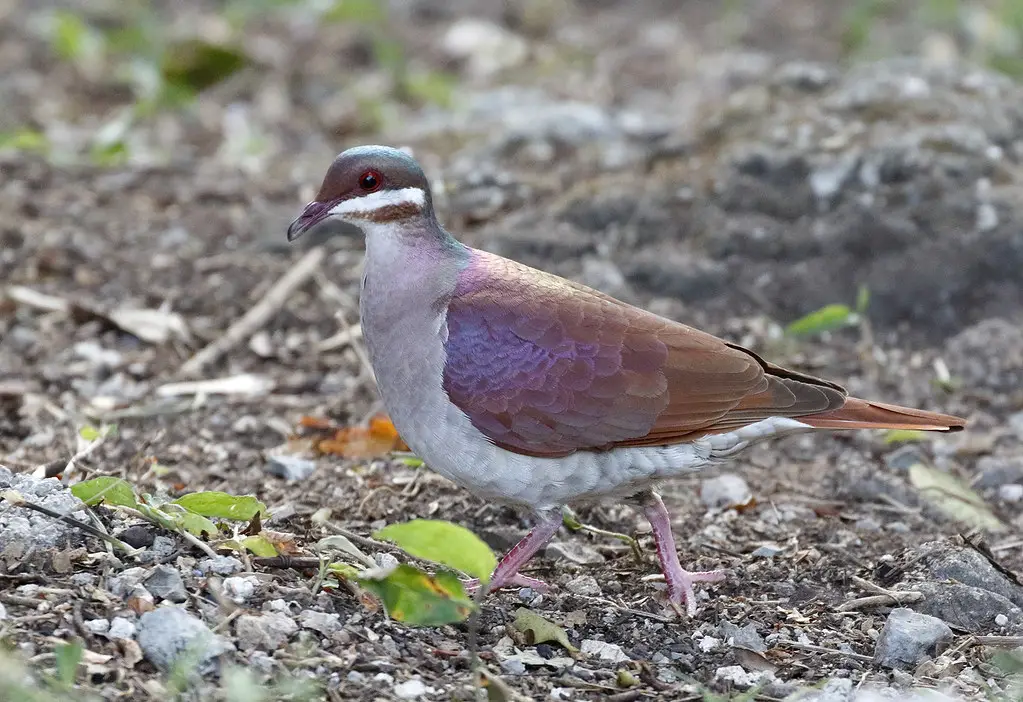
Image Source
- Scientific name: Geotrygon chrysia
- Lifespan: 7 years
- Size: 27–31 cm
- Native to: Florida
The Florida Keys are home to the migratory Key West Quail-dove. It is a tiny dove with light-colored underparts and a brown back. The band-tailed pigeon, which was long considered to be a subspecies of the latter, is closely related to the Key West quail-dove.
The habitat of this dove is mostly open spaces like pastures, golf courses, parks, and other natural regions. It consumes seeds, insects, and other tiny animals for food. On high ground or in trees, it constructs a twig nest where it incubates its eggs for around 16 days. After hatching, the chicks fledge after around 20 days.
4. Ruddy Quail-dove
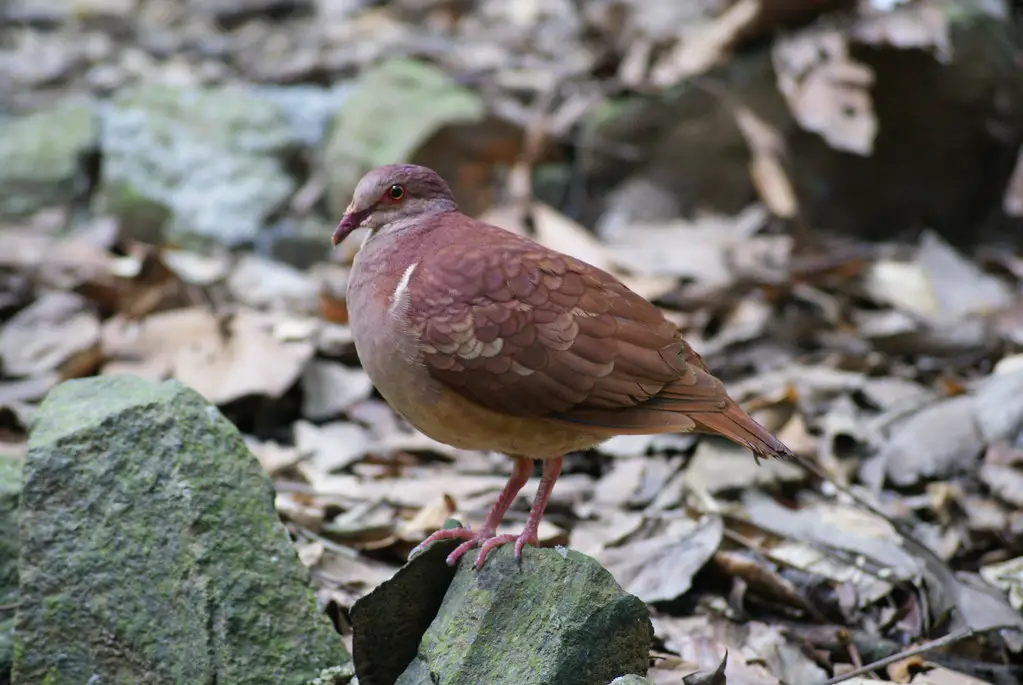
Image Source
- Scientific name: Geotrygon montana
- Lifespan: n/a
- Size: 19–28 cm
- Native to: West Indies, Central America, and tropical South America
A medium-sized dove known as the ruddy quail-dove (Geotrygon montana) may be found throughout much of North America and certain areas of Central America. They like wide spaces with plenty of grass, however, they may tolerate some brushy regions as well. Their food varies according to the season and includes seeds, fruits, and insects.
These creatures may be recognized rather simply because of their crimson tail and breast feathers. They are not extremely threatened by humans, but if you attempt to snap their photos or capture them, they could get upset.
5. Scaly-naped Pigeon (Black doves in Florida)

Image Source
- Scientific name: Patagioenas squamosa
- Lifespan: 8 years
- Size: 14 to 16 inches
- Native to: United States, Caribbean except for Jamaica and the Bahamas
Eastern North America is home to the little pigeon known as the scaly-naped pigeon. It’s mostly found in Florida and the Carolinas in the Southeast of the United States. The IUCN has this bird on its list of least threatened species, although there are still significant concerns from humans, such as habitat loss and alteration.
Its primary diet of plant debris makes it difficult for it to thrive in locations where there aren’t many remaining trees, which is one of the major causes of its decline. Additionally, because of habitat fragmentation brought on by human activities, it is more challenging for the pigeon to obtain food and shelter.
6. White-winged Dove
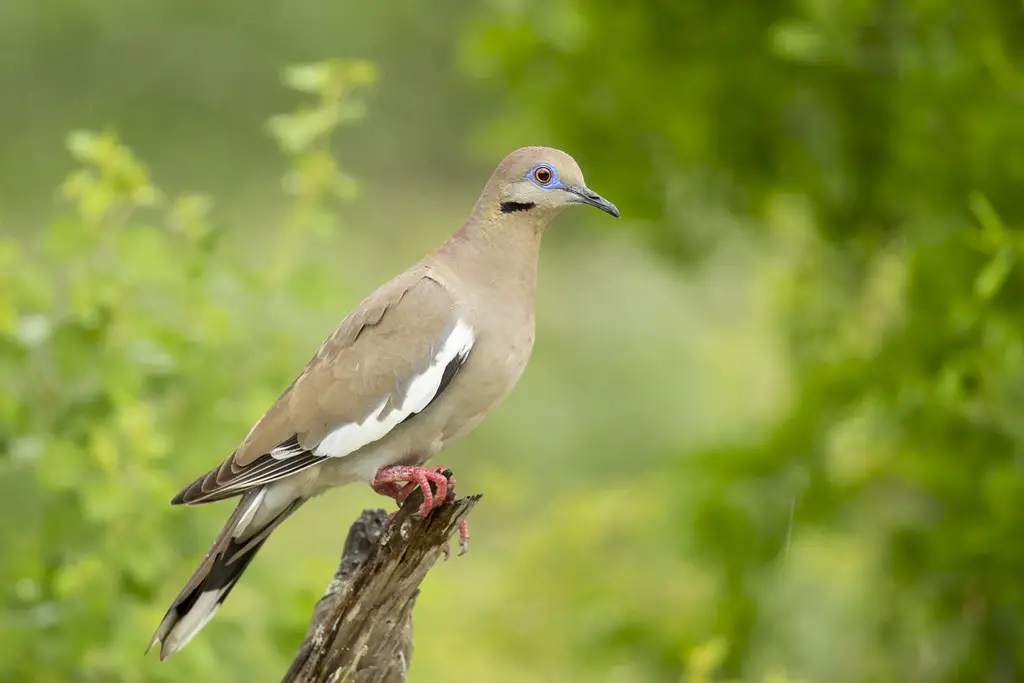
Image Source
- Scientific name: Zenaida asiatica
- Lifespan: 10-15 years
- Size: 11 in
- Native to: Southwestern United States through Mexico, Central America, and the Caribbean
Most of North America is home to a species of bird called the white-winged dove. The most prevalent dove in Florida, it may be found all around the state.
The gentle white-winged dove prefers to dwell in wide spaces with access to an abundance of food, water, and places to lay its eggs. It typically lays two eggs and constructs its nests on the ground or in low trees.
In the eastern and central United States, the white-crowned pigeon migrates. It may also be found in areas of Mexico and Canada.
Because it consumes crops and causes property damage, the white-crowned pigeon is a prominent target for hunters. Because of hunting and habitat destruction, its population has been declining over the last several years.
7. Zenaida Dove

- Scientific name: Zenaida aurita
- Lifespan: 18 years
- Size: 11–12 in
- Native to: the Caribbean and the tip of the Yucatán Peninsula
Birds that migrate through the southern United States include zenaida doves. They are a species of dove recognized for their stunning blue and green feathers.
The Zenaida flower, which serves as these birds’ primary food source throughout their trip, inspired the name of the Zenaida dove. Zenaida doves travel to Mexico or Florida in the winter to escape the cold.
Due to the loss in their population size and natural habitat, zenaida doves are classified as an endangered species. However, because to conservation initiatives, their number has been gradually increasing over the last several decades.
8. Eurasian Collared-Dove
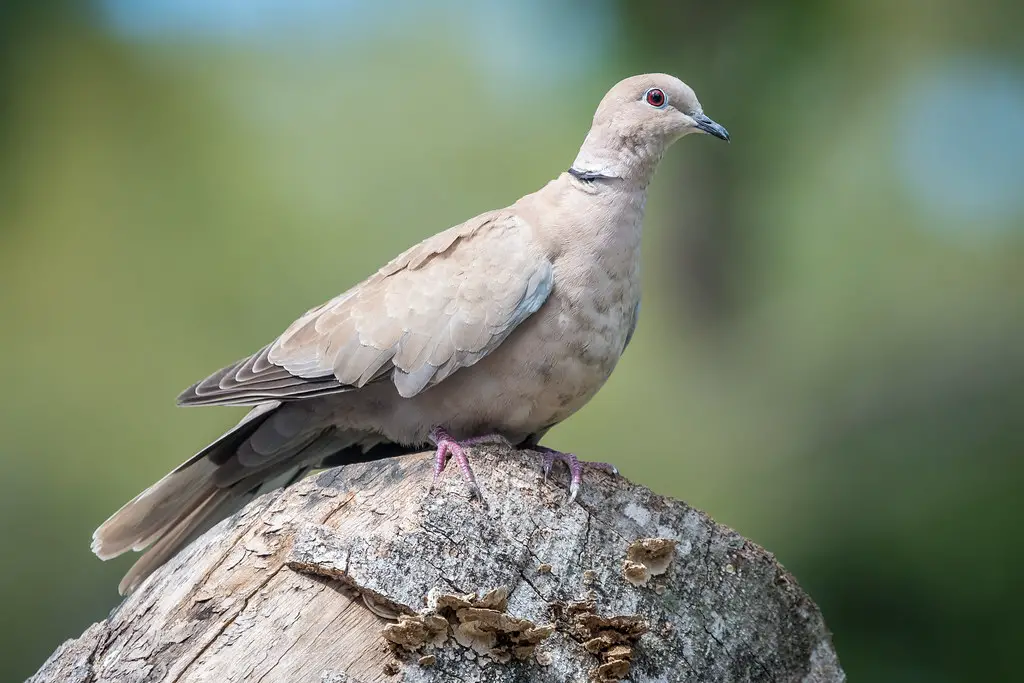
Image Source
- Scientific name: Streptopelia decaocto
- Lifespan: 3 years
- Size: 12-14 inches
- Native to: Bay of Bengal region (India, Sri Lanka, Myanmar
The Eurasian Collared-Dove is a species of a dove that may be found in North America, Central America, and the United States. One of the few native birds of North America that can thrive in cities, it is a crucial species for ornithologists and environmentalists.
The Eurasian Collared-Dove is an attractive bird with vivid feathers. Additionally, it has a unique collar around its neck to help keep predators away. Although poaching and habitat destruction have made this dove vulnerable, there are things you can do to support its preservation. You may contribute by using fewer pesticides, encouraging conservation efforts for animals, and planting trees to increase the number of natural habitats.
9. Rock Pigeon

Image Source
- Scientific name: Columba livia
- Lifespan: 6 years
- Size: 11-13 inches
- Native to: Europe to North Africa and India, it now lives in a wild or semi-wild conditions in cities all over the world, including most of North America
The rock pigeon inhabits a variety of environments, from subtropical rainforests to deserts, and is related to the wild turkey and the dove. It typically eats seeds, however, it will also consume fruits, insects, and other small animals.
Although rock pigeons spend most of their time at night, they sometimes saunter outside during the day if they feel comfortable or are looking for food. During the day, they often remain near to their nests, which may be as close as a few feet or as away as 500 feet!
Like other birds, rock pigeons sometimes construct nests in man-made buildings like skyscrapers and bridges. They often choose lofty locations with plenty of space for both themselves and their chicks.
10. Mourning Dove (most prevalent doves in Florida)
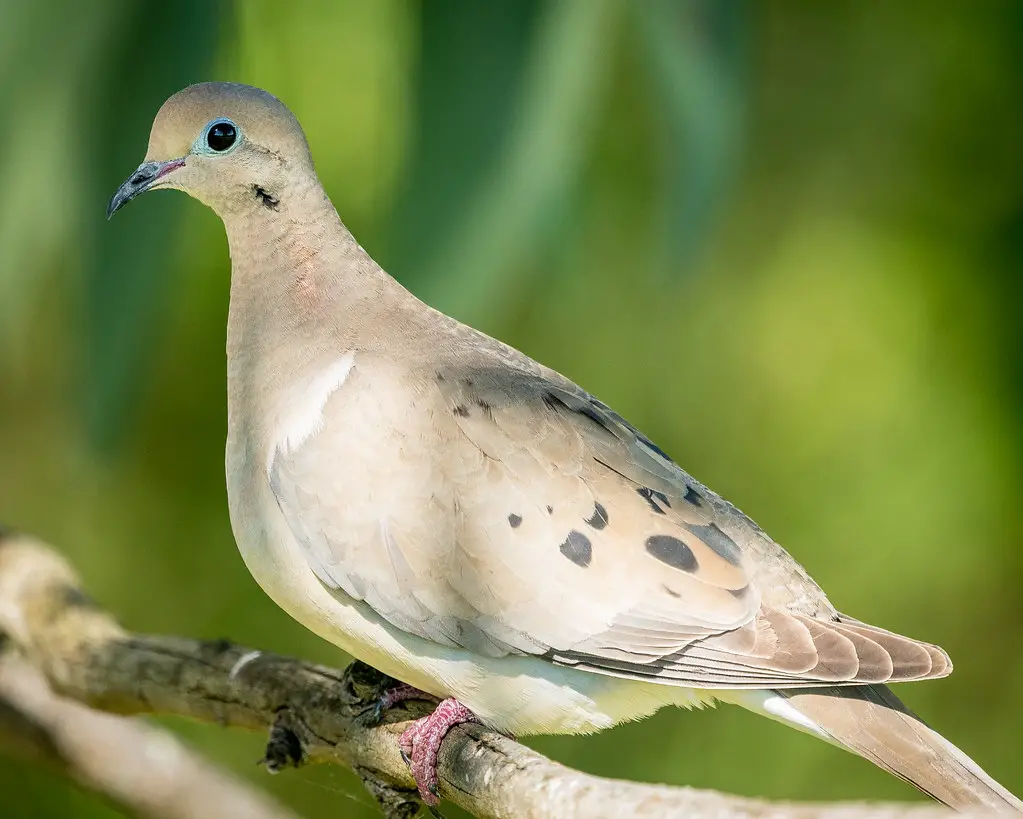
Image Source
- Scientific name: Zenaida macroura
- Lifespan: 2-5 years
- Size: 9-13 inches
- Native to: Southern Canada to central Mexico
The gorgeous Mourning Dove may be seen in Mexico and the United States. One of the most prevalent birds in North America, it is also known as the Woodpigeon or Scrub-Jay.
Peaceful mourning doves may dwell in groups of up to 100 birds. They often construct their nests in trees and eat seeds, grass, and insects as food. They are monogamous and often marry and have children together.
Mourning Doves have a characteristic call that is audible from a great distance. This scream is used by mourning doves to communicate with one another and to attract mates. When protecting his territory or letting other animals know he is there, the male mourning dove also has a loud voice that is audible.
Conclusion
Several dove species have been covered in this post. Doves are also renowned for their beauty and compassion, much like pigeons are.
However, if they are not kept in check, they might sometimes injure your plants. Therefore, you must also keep such birds under control.
Further Readings
- Types of Blue Birds in Florida
- Types of Birds of Prey in Florida
- Types of Shore Birds in Florida
- Types of Swallows in Florida
- Birds that Chrip at Night in Florida
- Types of White Birds in Florida
- Types of Owls in Florida
- Types of Red Birds in Florida
- Types of Hummingbirds in Florida
- Types of Hawks in Florida
- Types of Pink Birds in Florida
- Types of Herons in Florida
- Types of Black Birds in Florida

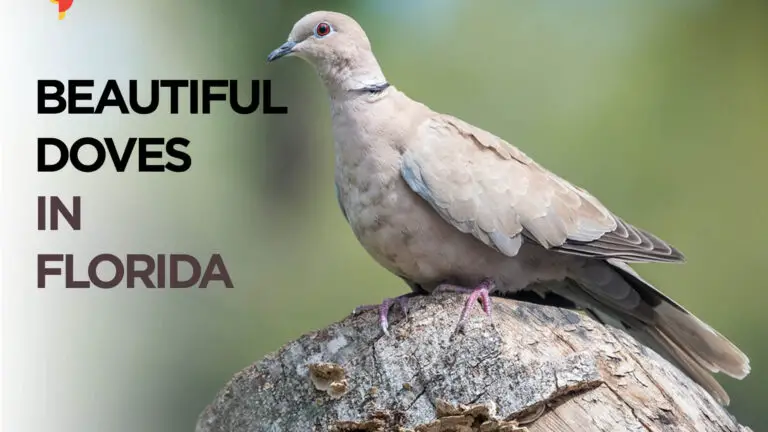
![8 Species Of Hawks In North Carolina [Images + Ids]](https://birdsology.com/wp-content/uploads/2023/02/22988829524_d7315189e5_b-600x400.jpg)
![4 Types of Doves in South Carolina [Images + IDs]](https://birdsology.com/wp-content/uploads/2023/09/51966837857_e62c6fbc37_b-600x400.jpg)
![10 Species of Hawks In Arkansas [Images + Ids]](https://birdsology.com/wp-content/uploads/2023/03/26566697545_31bbfc052c_b-600x400.jpg)
![8 Types of Owls in South Carolina [Images + Ids]](https://birdsology.com/wp-content/uploads/2023/03/23294438469_0c9f44f169_b-600x400.jpg)